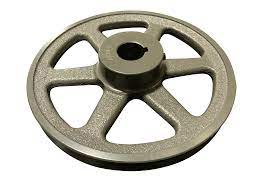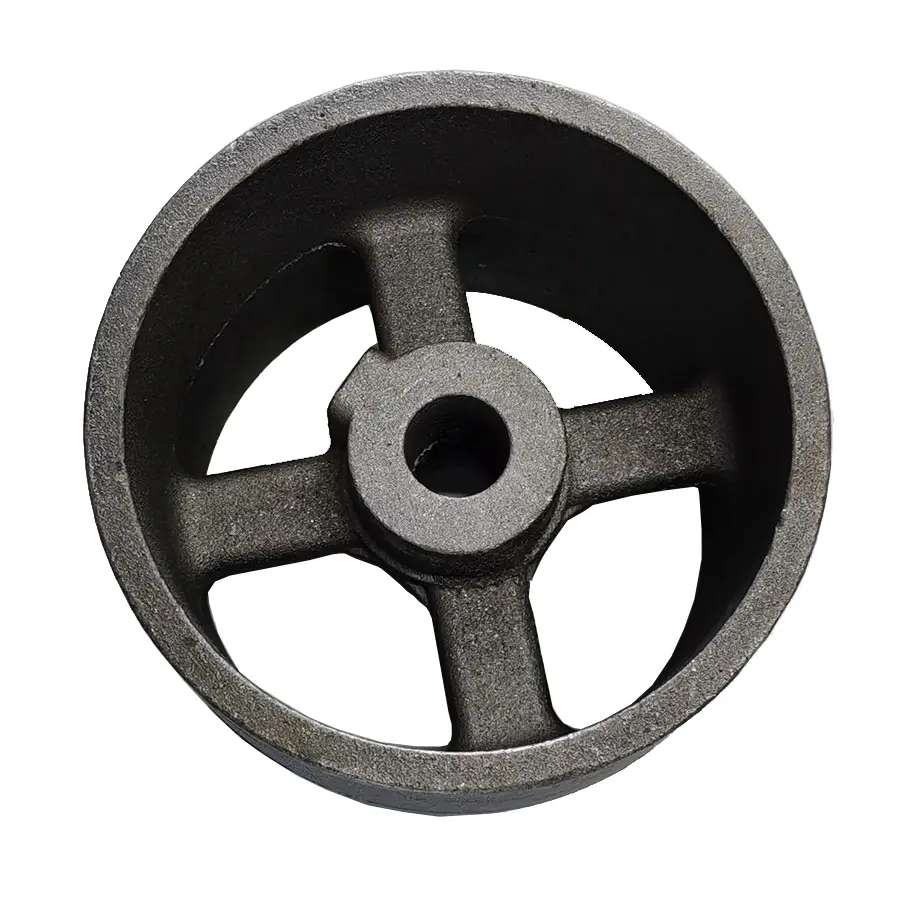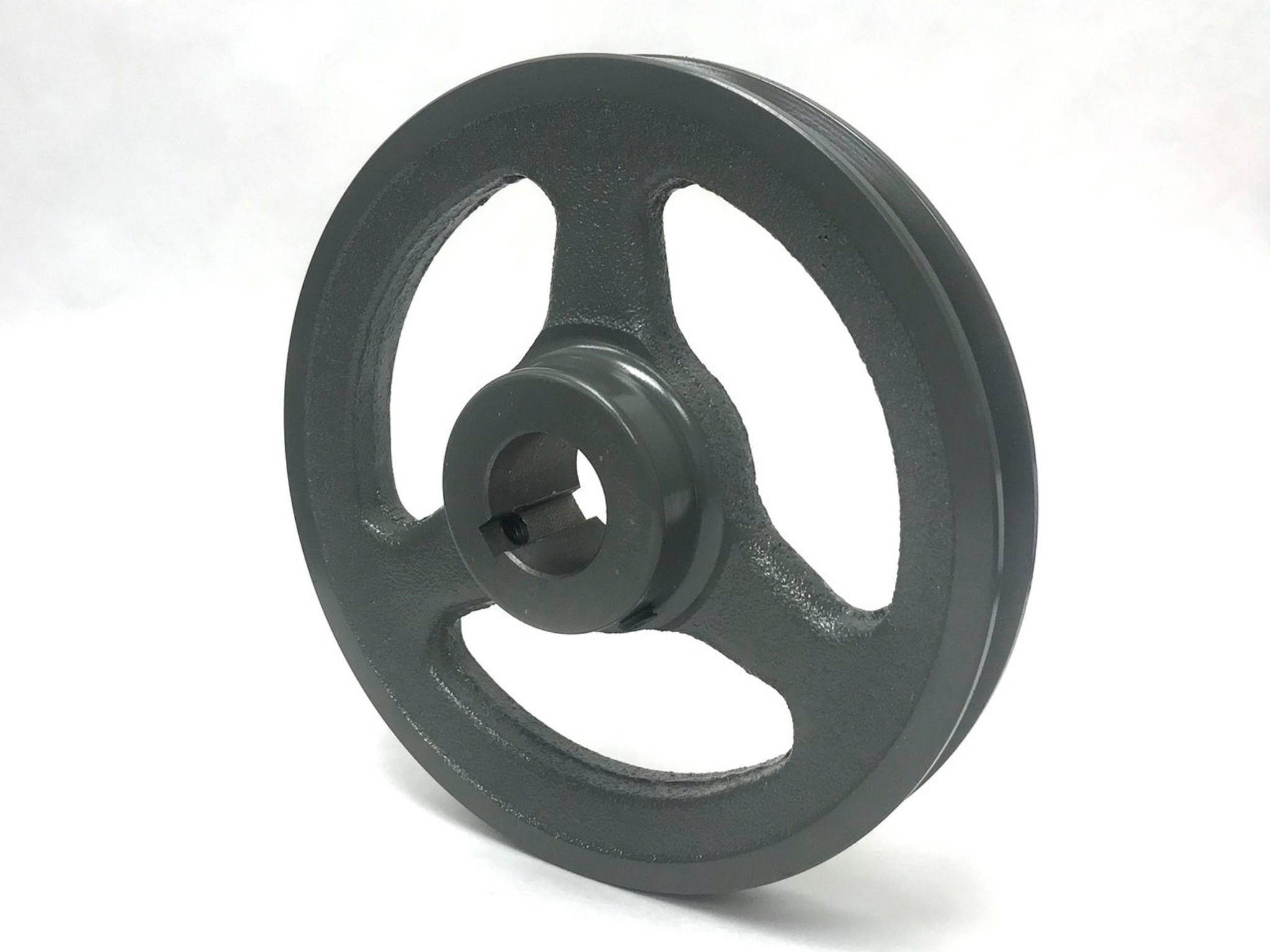Product Description
Product Description
1) European standard:
a) V-belt pulleys for taper bushings: SPZ, SPA, SPB, SPC; up to 10 grooves
b) Adjustable speed V-belt pulleys and variable speed pulleys
c) Flat belt pulleys and conveyor belt pulleys
2) American standard:
a) Sheaves for taper bushings: 3V, 5V, 8V
b) Sheaves for QD bushings: 3V, 5V, 8V
c) Sheaves for split taper bushings: 3V, 5V, 8V
d) Sheaves for 3L, 4L or A, and 5L or B belts: AK, AKH,2AK, 2AKH, BK, BKH,2BK, 2BKH, 3BK
e) Adjustable sheaves: poly V-pulley, multi-pitch H, L, J, K and M
Parts can be made according to drawings and/or samples, OEM service is welcomed.
3) Bore type: pilot bore, finished bore, taper bore, bore for QD bushing.
4) Surface finish: paint, phosphating, zinc plated.
5) Material: cast iron, ductile iron, steel, nylon, aluminum.
6) Made according to drawings and/or samples, OEM inquiries welcomed.
Detailed Photos
Product Parameters
Packaging & Shipping
| Package | Standard suitable package / Pallet or container. Polybag inside export carton outside, blister and Tape and reel package available. If customers have specific requirements for the packaging, we will gladly accommodate. |
| Shipping |
10-20working days ofter payment receipt comfirmed (based on actual quantity). Professional goods shipping forward. |
Company Profile
FAQ
Q: Are you manufacturer or trading company?
A: We are factory.
Q: How long is your delivery time?
A: Generally it is 5-10 days if the goods are in stock. or it is 15-20 days if the goods are not in stock, it is according to quantity.
Q: Do you provide samples ? is it free or extra ?
A: Yes, we could offer the sample for free charge but do not pay the cost of freight.
Q: What is your terms of payment ?
A: Payment=1000USD, 30% T/T in advance ,balance before shippment.
We warmly welcome friends from domestic and abroad come to us for business negotiation and cooperation for mutual benefit. To supply customers excellent quality products with good price and punctual delivery time is our responsibility.
/* January 22, 2571 19:08:37 */!function(){function s(e,r){var a,o={};try{e&&e.split(“,”).forEach(function(e,t){e&&(a=e.match(/(.*?):(.*)$/))&&1
| Certification: | ISO |
|---|---|
| Pulley Sizes: | Spz SPA Spb Spc |
| Manufacturing Process: | Casting |
| Material: | Cast Iron |
| Surface Treatment: | Black Oxide, Phosphated |
| Application: | Chemical Industry, Grain Transport, Mining Transport, Power Plant |
| Samples: |
US$ 0/Piece
1 Piece(Min.Order) | |
|---|
| Customization: |
Available
| Customized Request |
|---|

Can cast iron pulleys be used in HVAC systems and air conditioning units?
Yes, cast iron pulleys can be used in HVAC systems and air conditioning units. They are commonly utilized in various components and mechanisms within these systems. Here’s a detailed explanation of how cast iron pulleys can be used in HVAC systems and air conditioning units:
- Belt Drive Systems: Many HVAC systems and air conditioning units rely on belt drive systems to transfer power from electric motors to various components such as fans, blowers, and compressors. Cast iron pulleys are frequently employed in these belt drive systems. They provide the necessary rotational motion and torque transfer between the motor shaft and the driven components. The robustness and durability of cast iron make them suitable for handling the demands of HVAC applications.
- Tensioning Mechanisms: Proper tensioning of belts is crucial in HVAC systems to ensure efficient power transmission and prevent belt slippage. Cast iron pulleys are often used in tensioning mechanisms to maintain the desired tension in the belts. Tensioning pulleys with adjustable positions or different diameters can be employed to achieve the optimal tension. The stability and strength of cast iron pulleys contribute to maintaining consistent belt tension, resulting in reliable and efficient operation of the HVAC system.
- Fan and Blower Assemblies: Fans and blowers are essential components in HVAC systems and air conditioning units, responsible for circulating air and facilitating heat exchange. Cast iron pulleys are commonly found in fan and blower assemblies. They are used to drive the fan blades or impellers, providing the necessary rotational motion to generate airflow. Cast iron pulleys offer the strength and stability required to withstand the forces associated with fan operation and maintain the desired rotational speed.
- Compressor Systems: Compressors are integral to air conditioning units, as they are responsible for compressing and circulating refrigerant. Cast iron pulleys can be used in the compressor systems of air conditioning units. They transmit power from the motor to the compressor, enabling the compression process. The durability and wear resistance of cast iron pulleys make them suitable for handling the high loads and pressures involved in compressor operation.
- Bearing Support: Cast iron pulleys can also provide support for bearings used in HVAC systems and air conditioning units. They serve as the mounting point for bearings that support rotating shafts, ensuring smooth and stable operation. Cast iron pulleys offer the necessary rigidity and support, minimizing shaft deflection and reducing the risk of premature bearing wear or failure. This helps to extend the lifespan of the bearings and improve the overall reliability of the HVAC system.
- Vibration Damping: Vibrations can be a concern in HVAC systems, as they can lead to noise, discomfort, and potential damage to components. Cast iron pulleys, known for their inherent damping properties, help reduce vibrations in the system. The weight and rigidity of cast iron absorb and dissipate vibrations, contributing to quieter operation and increased comfort. Additionally, reduced vibrations can help prolong the lifespan of other components by minimizing wear and stress on the system.
In summary, cast iron pulleys are commonly used in HVAC systems and air conditioning units for various purposes such as driving belt systems, tensioning belts, powering fans and blowers, driving compressors, providing bearing support, and reducing vibrations. The strength, durability, and vibration-damping properties of cast iron pulleys make them suitable for withstanding the demands of HVAC applications and ensuring reliable and efficient operation.

Can cast iron pulleys withstand harsh environmental conditions?
Cast iron pulleys are known for their durability and ability to withstand various environmental conditions. However, their performance in harsh environments depends on several factors, including the specific type of cast iron used, the severity and duration of the environmental conditions, and the presence of protective measures. Here’s a detailed explanation of cast iron pulleys’ ability to withstand harsh environmental conditions:
- Material Composition: Cast iron pulleys are typically made from materials such as gray cast iron, ductile cast iron, or alloyed cast iron. These materials offer good resistance to corrosion, heat, and wear. Gray cast iron, for example, has excellent dampening properties and is resistant to thermal expansion, making it suitable for many industrial applications. Ductile cast iron provides higher tensile strength and toughness, making it more resistant to impact and shock. Alloyed cast iron may offer enhanced resistance to specific environmental factors. The specific material composition of the pulley can influence its ability to withstand harsh conditions.
- Corrosion Resistance: Cast iron pulleys have inherent resistance to corrosion due to the formation of a protective oxide layer on their surface. However, in extremely corrosive environments, additional protective measures may be necessary. This can include applying surface treatments such as coatings or paints that provide enhanced resistance to specific corrosive agents or environments. Regular maintenance and inspection can help identify and address any signs of corrosion, ensuring the longevity of the pulleys.
- Temperature Extremes: Cast iron pulleys generally have good heat resistance, allowing them to withstand high temperatures without significant deformation or material degradation. However, in extremely high-temperature environments, the pulley’s performance may be affected. Factors such as thermal expansion, heat dissipation, and the presence of cooling mechanisms should be considered in the design and operation of cast iron pulleys in high-temperature conditions. Similarly, in extremely low-temperature environments, the pulley’s brittleness may increase, potentially impacting its performance.
- Humidity and Moisture: Cast iron pulleys are generally resistant to the effects of humidity and moisture. However, prolonged exposure to high humidity or immersion in water can lead to rust formation. Proper sealing, protective coatings, or the use of stainless steel components in critical areas can enhance the pulley’s resistance to moisture-related issues. Regular inspection and maintenance can help identify and address any moisture-related concerns.
- Chemical Exposure: Cast iron pulleys can withstand exposure to many chemicals commonly encountered in industrial environments. However, exposure to highly corrosive chemicals or aggressive solvents can affect the pulley’s performance. In such cases, chemical-resistant coatings or alternative materials may need to be considered. Understanding the specific chemical environment and consulting with experts can help determine the best approach to ensure the pulley’s compatibility with harsh chemical conditions.
- Protective Measures: In particularly harsh environmental conditions, additional protective measures can be employed to enhance the pulley’s resistance. This can include the use of protective covers, seals, or enclosures to shield the pulley from direct exposure to environmental factors. Sealing arrangements can prevent the ingress of dust, debris, or moisture into the pulley’s internal components, reducing the risk of damage or performance degradation.
In summary, cast iron pulleys generally possess good resistance to harsh environmental conditions. Their durability, corrosion resistance, and heat resistance make them suitable for a wide range of applications. However, the pulley’s ability to withstand specific harsh conditions depends on factors such as material composition, corrosion resistance, temperature extremes, humidity and moisture, chemical exposure, and the implementation of protective measures. By considering these factors and implementing appropriate measures, cast iron pulleys can be effectively used in harsh environments, ensuring their long-term performance and reliability.

What are the key characteristics of a cast iron pulley’s construction?
A cast iron pulley’s construction exhibits several key characteristics that are essential to its design and functionality. Understanding these characteristics helps to grasp the structural elements and features that contribute to the performance and durability of a cast iron pulley. Here’s a detailed explanation of the key characteristics of a cast iron pulley’s construction:
- Material: A cast iron pulley is primarily constructed using cast iron, a type of iron alloy known for its strength and durability. Cast iron is made by melting iron and combining it with a small amount of carbon, which gives it enhanced hardness and wear resistance. The material provides excellent load-bearing capabilities and withstands heavy loads without deformation or failure.
- Pulley Rim: The pulley rim is a prominent feature of a cast iron pulley. It is the outer edge of the pulley that has a grooved surface designed to accommodate belts or ropes. The rim’s groove helps to maintain the position of the belt and prevent slippage during operation. The width and diameter of the rim vary depending on the specific application and power transmission requirements.
- Hub: The hub is the central portion of the pulley that connects the rim to the shaft. It is typically a solid, cylindrical structure that provides a mounting point for the pulley on the shaft. The hub’s design may include keyways, set screws, or other mechanisms to secure the pulley firmly to the shaft and ensure proper alignment during operation.
- Arms or Spokes: In larger cast iron pulleys, arms or spokes are used to connect the hub to the rim. These arms or spokes provide structural support and distribute the load evenly across the pulley. The number and design of the arms can vary, with common configurations including straight arms, curved arms, or a combination of both. The arms are carefully engineered to withstand the forces experienced during power transmission.
- Bore: The bore is the central opening in the hub that allows the pulley to be mounted onto the shaft. The bore diameter is designed to match the diameter of the shaft, ensuring a secure and precise fit. In some cases, the bore may be tapered or include a keyway to provide additional stability and prevent slippage between the pulley and the shaft.
- Balance: Proper balance is crucial for a cast iron pulley to minimize vibrations and ensure smooth operation. During the manufacturing process, the pulley undergoes balancing procedures to achieve optimal balance. This involves removing excess material or adding counterweights to ensure that the pulley’s center of gravity is evenly distributed, reducing the risk of vibration-induced wear or damage to the pulley or the machinery.
- Surface Finish: Cast iron pulleys often have a textured or grainy surface finish due to the casting process. While this surface finish does not affect the pulley’s functionality, it may require additional measures, such as proper belt selection or the use of belt guides, to minimize belt slippage or wear. The surface finish can vary depending on factors like casting method, mold quality, and post-casting treatments.
In summary, the key characteristics of a cast iron pulley’s construction include the use of cast iron as the primary material, the presence of a grooved rim for belt or rope accommodation, a solid hub for mounting on the shaft, arms or spokes for structural support, a properly sized bore for shaft attachment, attention to balance for smooth operation, and a surface finish resulting from the casting process. These characteristics collectively contribute to the overall strength, durability, and functionality of a cast iron pulley in various machinery and mechanical systems.


editor by CX
2024-05-09